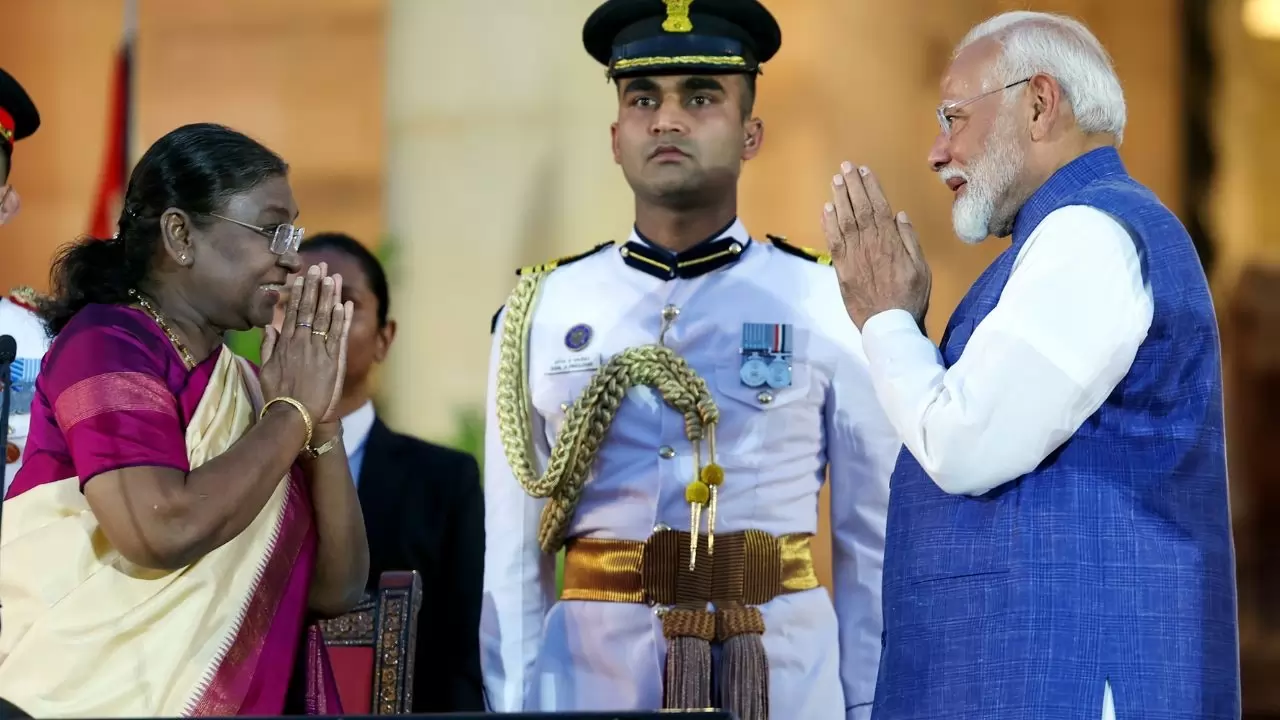
ANI
Modi 3.0: Narendra Modi was sworn in for his third consecutive term as Prime Minister at Rashtrapati Bhavan, alongside 72 ministers on Sunday. This achievement places Modi, aged 73, on par with Jawaharlal Nehru, who also served three consecutive terms as India’s first Prime Minister. For the first time, Modi will share power after the BJP lost its outright majority in the Lok Sabha following a fiercely contested election.
Reflecting the principles of 'coalition dharma', the new Council of Ministers includes 11 members from NDA partners. This diverse team consists of 30 Cabinet Ministers, five Ministers of State with Independent Charge, and 36 Ministers of State. Portfolio assignments are yet to be announced.
The Council of Ministers aims for inclusive representation, which features 27 members from Other Backward Classes (OBC), 10 from Scheduled Castes (SC), five from Scheduled Tribes (ST), and five from minority groups. Notably, the new team is that 18 senior Ministers will lead major ministries, ensuring experienced leadership.
While the new Cabinet has several prominent members, some notable names were absent, sparking discussions about the strategic decisions behind the selections. The announcement of portfolios is highly anticipated as it will define the direction and priorities of Modi’s third term.
1. Grand Ceremony at Rashtrapati Bhavan: The swearing-in event was held at the Rashtrapati Bhavan lawns, where President Droupadi Murmu administered the oath to Narendra Modi and his Council of Ministers.
2. Historic Third Term: Narendra Modi became the first Prime Minister since Jawaharlal Nehru to secure a third consecutive term. This time, however, he leads a full coalition government as the BJP did not achieve a majority in the Lok Sabha elections.
3. New Faces in the Cabinet: New entrants in Modi’s Cabinet include BJP chief JP Nadda, former Madhya Pradesh CM Shivraj Singh Chouhan, former Haryana CM Manohar Lal Khattar, six-time Sundargarh MP Jual Oram, and BJP Gujarat unit chief CR Patil. Jitin Prasada from Uttar Pradesh and former Karnataka minister V Somanna were also sworn in as Ministers of State.
4. Returning Ministers: Familiar faces returning to the Cabinet are Amit Shah, Rajnath Singh, S Jaishankar, Nirmala Sitharaman, Nitin Gadkari, Piyush Goyal, Pralhad Joshi, Jyotiraditya Scindia, Ashwini Vaishnaw, Kiren Rijiju, Dharmendra Pradhan, Sarbananda Sonowal, Bhupender Yadav, Giriraj Singh, Gajendra Singh Shekhawat, and G Kishan Reddy.
5. NDA Allies' Representation: NDA allies like Chirag Paswan (LJP), HD Kumaraswamy (JD(S)), Jitan Ram Manjhi (Hindustan Awam Morcha), Lalan Singh (JD(U)), and Kinjarapu Ram Mohan Naidu (TDP) were inducted as Union ministers of Cabinet rank.
6. Ministers of State: Jitendra Singh, Ramdas Athawale, Nityanand Rai, Arjun Ram Meghwal, Shripad Naik, Rao Inderjit Singh, and Krishan Pal Gurjar returned as Ministers of State. Eknath Shinde’s Shiv Sena, represented by Prataprao Jadhav, and RLD chief Jayant Chaudhary were also given ministerial roles, alongside Apna Dal's Anupriya Patel.
7. Diverse Attendance: Around 8,000 guests, including leaders from neighboring countries and the Indian Ocean Region such as Bangladesh, Sri Lanka, the Maldives, Bhutan, Nepal, Mauritius, and Seychelles, attended the ceremony.
8. Inclusive Invitations: Members of the transgender community, laborers, and sanitation workers who contributed to constructing the new Parliament building were invited to the ceremony.
9. Opposition Participation: Congress President Mallikarjun Kharge attended the swearing-in as his 'constitutional duty' as the Leader of Opposition in the Rajya Sabha. However, several opposition leaders, including those from the Trinamool Congress and the Left, declined the invitation.
10. NDA’s Electoral Performance: In the recent Lok Sabha elections, the BJP-led National Democratic Alliance (NDA) secured 293 seats. The BJP alone won 240 seats, falling short of the majority mark of 272, marking a significant shift from its previous single-party dominance.





Copyright © 2025 Top Indian News
